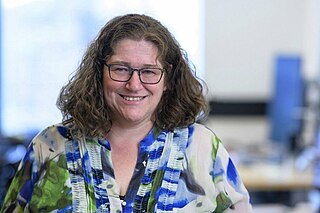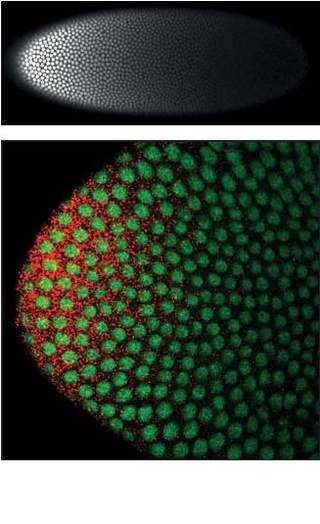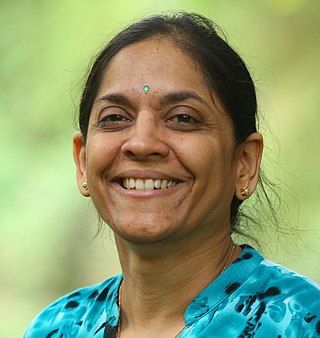
Glia, also called glial cells (gliocytes) or neuroglia, are non-neuronal cells in the central nervous system and in the peripheral nervous system that do not produce electrical impulses. The neuroglia make up more than one half the volume of neural tissue in the human body. They maintain homeostasis, form myelin, and provide support and protection for neurons. In the central nervous system, glial cells include oligodendrocytes, astrocytes, ependymal cells and microglia, and in the peripheral nervous system they include Schwann cells, and satellite cells.

Glutamate receptors are synaptic and non synaptic receptors located primarily on the membranes of neuronal and glial cells. Glutamate is abundant in the human body, but particularly in the nervous system and especially prominent in the human brain where it is the body's most prominent neurotransmitter, the brain's main excitatory neurotransmitter, and also the precursor for GABA, the brain's main inhibitory neurotransmitter. Glutamate receptors are responsible for the glutamate-mediated postsynaptic excitation of neural cells, and are important for neural communication, memory formation, learning, and regulation.
Gerald Mayer Rubin is an American biologist, notable for pioneering the use of transposable P elements in genetics, and for leading the public project to sequence the Drosophila melanogaster genome. Related to his genomics work, Rubin's lab is notable for development of genetic and genomics tools and studies of signal transduction and gene regulation. Rubin also served as a vice president of the Howard Hughes Medical Institute (2003–2020) and founding executive director of its Janelia Research Campus.
Tobias Bonhoeffer is a German-American neurobiologist. He is director of the department Synapses – Circuits – Plasticity and current managing director at the Max Planck Institute for Biological Intelligence in Martinsried near Munich.
Jean Duthie Beggs is a Scottish geneticist. She is the Royal Society Darwin Trust Professor in the Wellcome Trust Centre for Cell Biology at the University of Edinburgh.
Andrea Hilary Brand is the Herchel Smith Professor of Molecular Biology and a Fellow of Jesus College, Cambridge. She heads a lab investigating nervous system development at the Gurdon Institute and the Department of Physiology, Development and Neuroscience. She developed the GAL4/UAS system with Norbert Perrimon which has been described as “a fly geneticist's Swiss army knife”.

Dana Pe'er, Chair and Professor in Computational and Systems Biology Program at Sloan Kettering Institute is a researcher in computational systems biology. A Howard Hughes Medical Institute (HHMI) Investigator since 2021, she was previously a professor at Columbia Department of Biological Sciences. Pe'er's research focuses on understanding the organization, function and evolution of molecular networks, particularly how genetic variations alter the regulatory network and how these genetic variations can cause cancer.
Usha Vijayraghavan is an Indian molecular biologist. She is on the faculty of the Department of Microbiology and Cell Biology, at the Indian Institute of Science. Her major research interests are Molecular Genetics, Plant Development.

Jennifer Lea Stow is deputy director (research), NHMRC Principal Research Fellow and head of the Protein Trafficking and Inflammation laboratory at the Institute for Molecular Bioscience (IMB), The University of Queensland, Australia. She received a PhD from Monash University in Melbourne in 1982, postdoctoral training at Yale University School of Medicine (US) in the Department of Cell Biology. Her first faculty position was as an assistant professor at Harvard University in the Renal Unit, Departments of Medicine and Pathology at the Massachusetts General Hospital in Boston.
Roop Mallik is an Indian biophysicist who works on nanoscale molecular motor proteins that transport material such as viruses, mitochondria, endosomes etc. inside living cells. The motors, such as kinesin and dynein generate forces of pico-newton order to carry our various cellular processes namely cell division, vesicular transport, endocytosis, molecular tethering etc. His lab is working to understand how motor proteins help in degradation and clearance of pathogens, and also how these motors work inside the liver to maintain systemic lipid homeostasis in the animal. Mallik is currently a professor at the Department of Biosciences and Bioengineering, Indian Institute of Technology Bombay.

Hugo J. Bellen is a professor at Baylor College of Medicine and an investigator emeritus at the Howard Hughes Medical Institute who studies genetics and neurobiology in the model organism, Drosophila melanogaster, the fruit fly.

Sarah Amalia Teichmann is a German scientist, the former head of cellular genetics at the Wellcome Sanger Institute and a visiting research group leader at the European Bioinformatics Institute (EMBL-EBI). She serves as director of research in the Cavendish Laboratory, Professor at the University of Cambridge and Cambridge Stem Cell Institute, and is a senior research fellow at Churchill College, Cambridge.

Homeotic protein bicoid is encoded by the bcd maternal effect gene in Drosophilia. Homeotic protein bicoid concentration gradient patterns the anterior-posterior (A-P) axis during Drosophila embryogenesis. Bicoid was the first protein demonstrated to act as a morphogen. Although bicoid is important for the development of Drosophila and other higher dipterans, it is absent from most other insects, where its role is accomplished by other genes.

Professor Maneesha Inamdar is a stem cell and developmental biologist conducting research at Bangalore, India. She is presently Director of inStem, India’s first stem cell institute. She is on deputation from the Jawaharlal Nehru Centre for Advanced Scientific Research (JNCASR), Bangalore. She is an elected fellow of the Indian Academy of Sciences and the Indian National Science Academy and a J C Bose National Fellow.
Tara Keck is an American-British neuroscientist and Professor of Neuroscience and Wellcome Trust Senior Research Fellow, at University College London working in the Department of Neuroscience, Physiology, and Pharmacology. She is the Vice-Dean International for the Faculty of Life Sciences. She studies experience-dependent synaptic plasticity, its effect on behaviour and how it changes during ageing and age-related diseases. She has worked in collaboration with the United Nations Population Fund on approaches for healthy ageing. Her recent work has focused on loneliness in older people, with a focus on gender. She was named a UNFPA Generations and Gender Fellow in 2022.

Yorgo E. Modis is Professor in Virology and Immunology, and a Wellcome Trust Senior Research Fellow at the Department of Medicine, University of Cambridge. He is head of The Modis Lab in the Molecular Immunity Unit at the MRC Laboratory of Molecular Biology. He studies cellular mechanisms of viral gene sensing and silencing. His group employs a diverse set of complementary biophysical approaches including cryo-electron microscopy (cryoEM), X-ray crystallography, solution biophysics, fluorescence microscopy and cell biological approaches to understand the cellular mechanisms of viral gene sensing and silencing in molecular-level detail.
Nilay Yapici is a Turkish neuroscientist at Cornell University in Ithaca, New York, where she is the Nancy and Peter Meinig Family Investigator in the Life Sciences and Adelson Sesquicentennial Fellow in the Department of Neurobiology and Behavior. Yapici studies the neural circuits underlying decision making and feeding behavior in fruit fly models.
Cagla Eroglu is a Turkish neuroscientist and associate professor of cell biology and neurobiology at Duke University in Durham, North Carolina and an investigator with the Howard Hughes Medical Institute. Eroglu is also the director of graduate studies in cell and molecular biology at Duke University Medical Center. Eroglu is a leader in the field of glial biology, and her lab focuses on exploring the role of glial cells, specifically astrocytes, in synaptic development and connectivity.
Juri Rappsilber is a German chemist in the area of mass spectrometry and proteomics.
Marta Miączyńska is a Polish researcher in the field of molecular cell biology. A professor of biological sciences, she leads the Laboratory of Cell Biology at the International Institute of Molecular and Cell Biology in Warsaw (IIMCB). Since December 2018, she has been director of the IIMCB.









